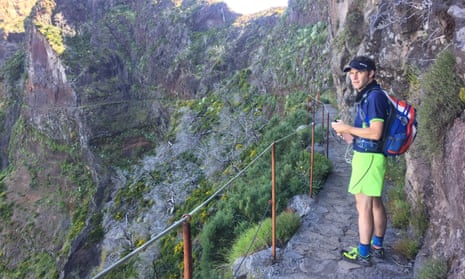I felt well prepped. My first serious trail run lay a week away. Madeira’s mountainous tracks and cliff-top coastline beckoned. Our route: the classic MIUT ultra spanning the Portuguese island in the north Atlantic. But we weren’t crazy. We would do it in two stages rather than in one, crazy-goat go. And we would hack off the first 35km. So that left around 80km over two days. Sure, the gradient chart for the first day looked like a heart attack victim’s cardiograph (3,600m of ascent). But, as I say, I felt good. I had trained hard. I wasn’t carrying any niggles.
Then, with a simple email, everything changed. The message was from Charlie, one of our Madeira trail-running trio. Of the three of us, he was the only one with any experience of serious long-distance running. He owns a high-end travel company in Morocco and talks casually of jogging in the Atlas mountains. He had already won our ear. Then I learned he had done the Marathon des Sables, a seriously gruelling six-day race in the Sahara, and our respect rose inordinately. So when he sent an email with the subject heading, “Everything weighs something”, I was primed to listen.
It’s obvious, of course. Except for air, nothing is weightless. Everything else had to fit into a backpack (a 12-litre rucksack, in my case). I had been excitedly purchasing bits and pieces over the past fortnight or so: some new sunglasses (with sporty reflective tint), a running visor (to look the part), a buff (to look like a Spanish biker). Anyone who has prepared for an endurance-type event will know that buying the kit is half the fun. Gradually, however, a hefty pile of stuff had begun to collect beside my bed.
The question of how to squeeze all this into my (much smaller) bag had, in a vague sort of way, been turning over at the back of my mind. Charlie’s email sent such thoughts scurrying to the front. To save weight, he was recommending that we portion out the essentials between us. So Jon, our mutual friend, was assigned toothpaste and sun cream (“small tubes”), plus a phone charger and, weirdly, a knife. Channelling his inner nurse, Charlie put himself down for kinesiology tape, first-aid kit and anti-inflammatories. I got the leftovers: toilet roll, wet-wipes, water purification tablets. The email ended in the cavalier style of a Victorian-era Arctic explorer: “The rest is each-to-his-own.”
I look again at my pile. Forget 1-in-4 gradients: packing light suddenly seemed the insurmountable challenge ahead. Start with the non-negotiables, I resolved. So into my bag went my passport, my inhaler, my survival “space blanket” and my phone. The remainder divvied up into three broad categories: fluids, foodstuffs and comfort-offering accoutrements. But what to take?
For fluids, I decided to keep it old-school: a modest-sized bottle in a side pocket, plus a 1.5l hydration. I’m prone to cramps, so I allowed myself some electrolyte tablets as well. What I didn’t pack were purification tablets: I’d searched high and low in Porto, where I live, but couldn’t find them anywhere. We would just have to bet on Madeira’s watercourses being free of cow muck and chemicals.
Subsequent events taught me two key lessons. First, water is seriously heavy. Second, I wish I had known to fill up whenever and wherever I got the chance. While streams and irrigation channels were two-a-penny on Madeira’s lower slopes, the story was altogether different above the treeline. Climbing to a lengthy 1,500m ridgeline, I found myself out of water. My legs turned heavy, my head hurt. If we hadn’t eventually stumbled on a mountain spring, my adventure would have been over almost before it began.
So, to food. Into the bag went two 250g bags of nuts, and some energy bars. At the last minute, I also snuck in a cheese sandwich and banana, both of which emerged from my bag totally squished but no less edible. Our general game plan was to keep nibbling through the day, then carb up in the evening. In the end, we arrived at our night-stop after dark and discovered the hamlet’s two eateries long shut. In the days after the run, I barely left the fridge.
Finally to kit: painkillers, salt tablets, plasters, head-torch, bank card, toothbrush. Most of the rest related to staying warm. My dilemma wasn’t the daylight hours. The forecast was saying around 25C, even at altitude. It was packing for the night that threw me. I spent hours lusting over one-man tents online, but all fell far outside my price range. I opted instead for just a sleeping bag, plus lots of layers. I figured I could sleep in my fleece and rain jacket, plus the spare clothes I had earmarked for the journey home. Assigned by lack of space to the “leave” pile was a roll mat, an inner lining for the sleeping bag, and a thin puffer coat. Did I sleep well? No, not especially, but I felt emboldened for roughing it.
In retrospect, if I were to have shelled out on anything, a top-notch sleeping bag would probably have topped the list: it would have taken up less room and, being warmer, saved on me packing extra clothes. But, in general, I felt I had whittled everything down as much as possible. Only my weight of expectation remained alarmingly high – and Madeira, runners’ heaven that it is, did not disappoint.
